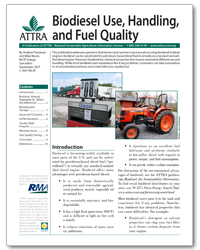Biodiesel Use, Handling, and Fuel Quality
By Andrew Pressman and Mike Morris, NCAT Energy Specialists
Abstract
This publication addresses questions that farmers and ranchers may have about using biodiesel in diesel engines. Biodiesel can be substituted for petroleum-based diesel fuel in virtually any standard unmodified diesel engine. However, biodiesel has chemical properties that require somewhat different use and handling. While most biodiesel users experience few if any problems, consumers can take precautions to avoid potential problems associated with poor quality fuel.
Introduction
Biodiesel is becoming widely available in most parts of the U.S. and can be substituted for petroleum-based diesel fuel (“petrodiesel”) in virtually any standard unmodified diesel engine. Biodiesel offers many advantages over petroleum-based diesel:
- It is made from domestically produced and renewable agricultural products, mainly vegetable oil or animal fat.
- It is essentially non-toxic and biodegradable.
- It has a high flash point (over 300ºF) and is difficult to light on fire with a match.
- It reduces emissions of many toxic air pollutants.
- It functions as an excellent fuel lubricant and performs similarly to low-sulfur diesel with regards to power, torque, and fuel consumption.
- It can greatly reduce carbon emissions.
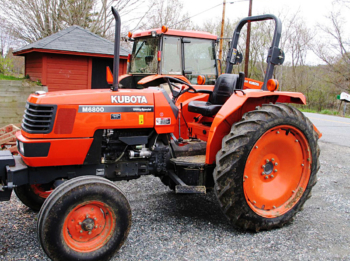
Diesel tractor. Photo: Vern Grubinger
For discussion of the environmental advantages of biodiesel, see the ATTRA publication Biodiesel: the Sustainability Dimensions.
Most biodiesel users pour it in the tank and experience few if any problems. Nonetheless, biodiesel has chemical properties that can cause difficulties. For example:
- Biodiesel’s detergent or solvent properties can clog your fuel filter as it cleans carbon deposits from your engine.
- Compared to petrodiesel, biodiesel has somewhat worse cold-flow properties.
- Biodiesel degrades rubber and certain other materials, making it incompatible with some fuel lines, rubber gaskets, and other engine parts.
This article offers suggestions to help farmers and other consumers get the benefits of biodiesel while avoiding performance and equipment problems.
| Caution: If you are making your own fuel, using and storing large quantities of biodiesel, or selling fuel commercially, you will need to take many safety, legal, and quality-related precautions beyond the ones described here. |
Biodiesel, Ethanol, Vegetable Oil: What’s the Difference?
Biodiesel is a very different substance from ethanol. Ethanol (or grain alcohol), the familiar alcohol found in alcoholic beverages, is commonly blended with gasoline (not diesel fuel) and is made by fermenting grains or other plants that contain sugar. Fermentation is a biological process accomplished by yeasts and bacteria.
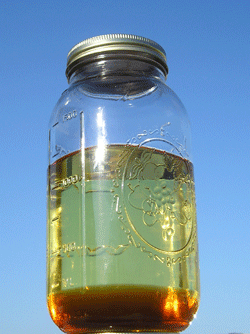
Jar of biodiesel. Photo: www.biodieselcommunity.org
Biodiesel is essentially permanently thinned plant or animal-based oil, with a viscosity approximating that of standard #2 diesel fuel. Biodiesel can be made from virtually any plant oil or animal fat. Making biodiesel is a chemical process. During this chemical reaction, a thick gooey substance, glycerin, is released from the oil molecules and replaced with a comparatively thin and light alcohol, usually methanol.
Biodiesel is also very different from raw or “straight” vegetable oil (SVO). Almost any vegetable oil will combust, to one degree or another, in a diesel engine. So it’s possible to run most diesel engines on SVO. But this is a somewhat risky process, mainly since raw vegetable oil is too thick and viscous to run well in diesel engines.
Biodiesel will perform well in almost any standard diesel engine without modifications. On the other hand, to use SVO you will need to modify your engine. Conversion kits are readily available for $300 to $1,500.(1) Generally, conversion means installing a separate fuel tank, heater, and fuel line, along with various switches and controls. The idea is to thin the oil by heating it, while taking precautions to keep cold, gooey vegetable oil out of your engine. You start and run the engine on standard diesel fuel or biodiesel. Once the engine is warm and you’ve pre-heated the vegetable oil—stored in a separate tank—you can switch to SVO. Several minutes before turning off the engine, you switch back to standard diesel fuel or biodiesel, clearing all the SVO out of your engine and fuel lines.

Vegetable oil containers. Photo: Vern Grubinger
The U.S. Department of Energy, among many other organizations, cautions that SVO can reduce engine life and should not be considered a fuel for long-term use.(2) The use of SVO has been shown to cause piston ring sticking, injector and combustion chamber deposits, fuel system deposits, reduced power, reduced fuel economy, and increased exhaust emissions. Any of these conditions can reduce engine life, increase maintenance costs, or cause engine failure. Modern diesel engines are also equipped with catalytic converters, or filter traps, that are not designed to handle SVO.
Performance problems don’t necessarily happen quickly. Certain engines seem to tolerate SVO better than others, and some vehicles run trouble-free for years. On the other hand, many SVO users succeed initially, and are lulled into a false sense of security, only to run into serious problems later.(3)
Despite the very real risk of engine damage, SVO has certain advantages that may make it worth considering for some farming situations and equipment, especially in older engines. Using SVO is in some ways simpler than making your own biodiesel. Making biodiesel generally requires you to use methanol, a toxic chemical, and to dispose of glycerin, a waste product. By contrast, SVO is generally only filtered before use, and there are few if any waste products to deal with.
Biodiesel Blends and Blending
Biodiesel in its pure (100 percent) form is known as neat biodiesel or B100. It can be readily blended with petroleum diesel in any proportion. A B20 blend, for example, is 20 percent by volume biodiesel and 80 percent petrodiesel.
Different blends serve different purposes. Small amounts of biodiesel (B1-B2) add lubrication to low-sulfur fuels. Blends in the B20 to B50 range provide significant environmental benefits with a low increase in cost to consumers. Blending also reduces the likelihood of the solvency, material incompatibility, or cold weather problems discussed below.
The simplest method is splash blending. Biodiesel should always be poured on top of petroleum diesel, since it is slightly heavier. The two fuels will mix fairly well as the biodiesel gradually sinks through the lighter petrodiesel. Some form of agitation is needed, though, to achieve highly uniform fuel. Random samples of splash-blended fuel being marketed as B20 have been found to contain actual biodiesel content ranging from B2 to B90.(4)
You should avoid adding biodiesel to cold petrodiesel, since this may cause crystals to form. To prevent this from happening, you can blend biodiesel with kerosene (also called #1 diesel fuel) in a 50/50 mix before adding it to cold diesel fuel.(5) If crystals have already formed, the fuel will have to be heated until they dissolve.
Biodiesel Storage
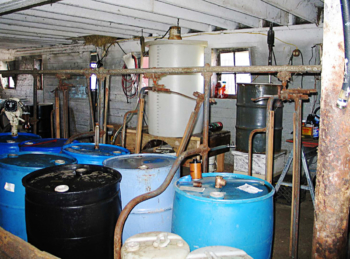
Storage barrels. Photo: Vern Grubinger
Biodiesel can be stored in standard petroleum diesel storage tanks with some precautions:
- Tanks that have previously been used to store diesel fuel should be cleaned before use. As noted below, biodiesel is an excellent solvent and will loosen deposits left by standard diesel fuel. Tanks should also be free of water, since this encourages bacterial growth.
- Tanks may be made of aluminum, steel, Teflon, or fluorinated polyethylene or polypropylene. Fiberglass is sometimes used, but should be approached with caution since some resins are not compatible with biodiesel.(4)
- Both petrodiesel and biodiesel can cause metal parts to oxidize, so you should replace any parts made of brass, bronze, copper, lead, tin, or zinc with aluminum or steel.
- If biodiesel or blended fuels are stored beyond around six months, fuel stabilizers should be added.(6) Old fuel will become acidic and form sediments and varnish.
- Biodiesel and biodiesel blends should be stored at temperatures at least 15 degrees above the pour point of the fuels.(7) The pour point is the temperature below which a fuel will not pour.
- Outdoor tanks should be located in cool shaded areas if possible.
| Caution: If you are storing large amounts of fuel, or selling it commercially, you will need to take many additional precautions and meet local laws and code requirements. |
Issues and Concerns
Issue #1: Solvent Effects and Filter Clogging
According to researchers at the University of Idaho, filter plugging is the most common problem experienced by biodiesel users.(4)
Biodiesel has excellent solvent properties and can be used as a cleaning agent and paint remover. (It can remove the paint on the side of your car or tractor, if you splash it around while filling the tank.) In fact, it can even dissolve concrete.(4)
Petroleum diesel often leaves a deposit in the bottom of fuel lines, tanks, and delivery systems. Biodiesel can loosen and dissolve these sediments, as well as rust and other materials. This causes fuel filters to become clogged—sometimes in a matter of hours after switching to B100. Symptoms of filter clogging include a sudden power loss or engine shuddering.
Older vehicles have more accumulated deposits, and are especially prone to filter clogging. Ideally, you should clean an old fuel tank before converting to biodiesel. An alternative is to switch to finer filters. Anyone using B100 should know how to change the fuel filter and should carry a spare fuel filter or two. Expect to change your fuel filter two or three times before all the deposits are cleaned out of your engine. If you are using a modest blend (B20 or lower), you are less likely to notice filter clogging.
Issue #2: Reduced Power
On average, B100 has about eight percent less energy content (BTU per gallon) than #2 petrodiesel, while B20 has one to two percent less energy content.(8) If you switch from standard diesel fuel to B100, you may notice a slight decrease in horsepower, torque, or fuel economy. At B20 or less, you probably won’t be able to tell the difference.
A cetane number is an indicator of diesel fuel quality, measuring the readiness of fuel to ignite when injected into the engine. Biodiesel’s cetane number is higher than that of standard diesel fuel, and this advantage may partly compensate for its lower BTU content. Because biodiesel ignites more readily in diesel engines than petrodiesel, some authorities recommend setting the injection timing back by two to three degrees from top-dead center. This will sometimes cause the engine to run quieter, although it may also slightly reduce your power.(9)
Issue #3: Cold Weather Performance
All diesel fuel, including petroleum-based fuel, begins to gel at cold temperatures. The temperature at which a cloud of wax crystals forms in the fuel is known as the cloud point. The cold filter plugging point is the lowest temperature at which fuel can be drawn through a metal screen filter.(10) The pour point is the temperature below which a fuel will not pour.
In general, biodiesel gels at somewhat higher temperatures than conventional #2 diesel. When wax crystals begin to form in biodiesel, the entire fuel tends to cloud at the same time. In contrast, petroleum diesel is made up of many different compounds that gel at different temperatures. When some of these begin to crystallize, others remain liquid to a much lower temperature.
The cloud point for standard #2 diesel fuel is around 5ºF. The cloud point for biodiesel depends on the feedstock and the amount of free fatty acids in the fuel. The cloud point for soy diesel is around 32ºF (4), compared to cloud points around 20ºF for canola and 12ºF for rapeseed.(11) Biodiesel made from used cooking grease or animal fats will tend to cloud at higher temperatures than biodiesel made from virgin oils. Biodiesel from the most highly saturated feedstocks may gel at temperatures as high as 50-55ºF.
Low-percentage biodiesel blends generally have cold weather properties similar to petrodiesel. The cloud point of B20 may be 3º-10ºF higher than #2 petrodiesel.(8)
Simple cold weather precautions include using engine block or fuel filter heaters and parking vehicles in or near a building. Fuel additives can also inhibit crystal growth and gelling in standard diesel fuel. Anecdotal reports suggest that few if any of these products work well on B100. They may be effective on blended fuel, however, since they will work on the petroleum-based portion of the fuel.
Issue #4: Softening Fuel Lines
Using a high-percentage biodiesel blend or B100 can cause certain types of elastomers and natural rubber compounds to bubble, bleed, soften, and degrade over time. Virtually all diesel vehicles made since the early 1990s use components that are compatible with B100.(4) But some older fuel hoses will need to be replaced.
Equipment changes are rarely if ever necessary with blends of B20 or lower.(8)
Besides rubber, other vulnerable materials identified by the National Biodiesel Board include polypropylene, polyvinyl, and Tygon. Although there have been a few reports of degraded injection pump seals, by far the most common problem you are likely to encounter is with rubber fuel lines. If you have an older vehicle, you should inspect your fuel lines frequently after you begin using biodiesel.
The good news is that these problems are likely to appear gradually, if they appear at all. Hoses will begin to soften and (eventually) weep. You are unlikely to experience a catastrophic failure.
| Biodiesel-Compatible Fuel Lines
The following fuel lines are claimed by their manufacturers to be
|
Issue #5: Engine Oil Dilution and Fuel Oxidation
In blends higher than B20, unburned biodiesel can make its way past the piston rings and into the oil pan.(8) This happens because biodiesel has a slightly higher viscosity and density than standard diesel. Eventually, this fuel in the engine oil can polymerize, causing oil sludge that coats metal surfaces and causes moving parts to stick.(4) If you are using biodiesel blends higher than B20, you may need to change your engine oil more frequently.
Issue #6: Microbial Growth
Water can sometimes drip through vents and collect at the bottom of fuel tanks. Certain varieties of algae, yeast, and fungi can grow at the interface of the fuel and water.(4) In order to prevent microbial growth, you should drain any water from the bottom of your fuel tank on a regular basis. Certain biocides can also be added to control microbial growth, but the dead microbes may plug filters.
| Case Study: Phil Foster Ranches
Phil Foster began using biodiesel on his organic vegetable farm near San Juan Bautista, California, in 2004. He saw the use of non-petroleum fuels as consistent with his philosophy as an organic vegetable farmer. He liked the idea that any fuel spills would be biodegradable and far less toxic than standard diesel. He was attracted by the air quality and health advantages for his family and his workers. And he liked the idea of purchasing fuel made from agricultural products, preferably ones grown locally or regionally. Phil didn’t have the time or inclination to make his own fuel, so he began purchasing biodiesel from a local retailer. Initially, he tried B100 in some of his vehicles, gradually expanding his usage as he became comfortable with the fuel’s performance. He also asked his supplier lots of questions about testing, standards, and feedstocks. By 2006, biodiesel made up 81 percent of the roughly 20,000 gallons of diesel fuel consumed annually by the farm’s tractors, pickups, and delivery trucks. Most of the farm’s diesel vehicles are now running B100, although with some of his older equipment Phil has been reluctant to go above B30. Overall, Phil comments that, “After four years of using biodiesel, we’ve had very good results.” He did experience some filter plugging when switching to biodiesel, and he now changes his filters at every service. He also went through a period recently where it seemed as if he needed to change filters more often than normal. “Maybe the fuel was a tad off … We’ll probably never know for sure.” Fuel economy may have decreased slightly, in the range of three to five percent. There have also been a few cold mornings (18º–20ºF) when the vehicles running on B100 would not start. Switching temporarily to B30 during cold weather has solved this problem, and all vehicles have started fine on B30. Phil recently bought a new truck, which he plans to run on B30 for the first six to twelve months—enough time for any problems to show up. Once he’s confident in the vehicle’s performance, he’ll switch it over to B100. |
ASTM Standards
The American Society for Testing and Materials (ASTM) is the industry organization that defines legal fuel standards: minimum values that a fuel must meet to operate safely in a compression ignition engine.
All diesel engines sold in the U.S. are manufactured to meet ASTM D975, the legal standard for petrodiesel. In 2001, ASTM approved a standard specifically for biodiesel, ASTM D6751. This standard covers all biodiesel fuels, regardless of feedstock or processing method.
These legal requirements only apply to fuel that is sold. Home brewers, cooperatives, and farms making fuel for their own use are not required to meet ASTM D6751.
ASTM testing must be done by qualified laboratories and requires expensive equipment.
| Are You Sure Your Fuel Is Meeting ASTM Standards?
A study released in November 2006 suggests that inconsistent fuel quality continues to be a real issue for the US biodiesel industry—despite the legal requirement that commercial fuel must meet ASTM standards. Co-funded by the National Biodiesel Board (NBB) and the National Renewable Energy Laboratory (NREL), the study randomly collected biodiesel samples from 32 fuel distributors around the country between November 2005 and July 2006. Half of the samples failed to meet at least one of the ASTM D6751 specifications, and some samples failed multiple standards. Thirty percent of the samples failed to meet the flash point standard, and one-third of the samples failed to meet the total glycerin standard.(18) |
The BQ-9000 Program
The National Biodiesel Board has instituted a cooperative and voluntary quality assurance program called BQ-9000. The program was developed to ensure a more consistent quality for biodiesel being produced, marketed, and used. While ASTM standards only cover fuel quality, BQ-9000 encompasses storage, sampling, testing, blending, shipping, distribution, and fuel management practices.
Any biodiesel producer, marketer or distributor of biodiesel or biodiesel blends in the U.S. or Canada is eligible for program accreditation. Accredited manufacturers and certified marketers under this program are listed on the BQ-9000 website.
| Case Study: The Minnesota Biodiesel Mandate
In September 2005, Minnesota passed a law requiring all diesel fuel to contain two percent biodiesel. Soon after the mandate went into effect, Minnesota truckers began to experience sporadic problems, including trucks breaking down on the road, hefty repair bills, and lost road time. The culprit was clogged fuel filters and it soon became apparent that biodiesel was to blame. Cold weather gelling was found to be the main problem. In December 2005, the Minnesota Department of Commerce confirmed that some biodiesel producers had shipped biodiesel that did not meet ASTM D6751 specification for free and total glycerin.(12) “There’s no room for poor-quality biodiesel in the marketplace,” said Steve Howell, technical director with the National Biodiesel Board. “Although investigations have indicated that other factors unrelated to biodiesel may have led to at least some of the filter- plugging reports in Minnesota, there’s no question that off -specification biodiesel can have a severe reaction in cold weather, even in low blends.”(13) All Minnesota biodiesel producers subsequently had to prove that their fuel met ASTM specifications.(12) After implementing additional quality measures, the Department of Commerce reaffirmed the ruling that diesel fuel was required to contain two percent biodiesel meeting ASTM D6751 specifications. Minnesota’s experience showed that even a low percentage of off -spec biodiesel—as low as two percent!—can cause performance problems. |
Will Biodiesel Void My Warranty?
Many farms and ranches are discouraged from using biodiesel, especially in newer vehicles, because of fears that they will”void their warranties.”
It’s a good idea to check with your vehicle manufacturer to see if they have an official policy on the use of biodiesel. Most major engine companies have formally stated that biodiesel blends below 20 percent that meet ASTM D6751 will not void their engine warranties.
The Clean Fuels Alliance America (formerly the National Biodiesel Board) has posted on its website several statements from engine companies. John Deere, Caterpillar, and New Holland are among the many companies that have adopted policies supportive of biodiesel. Other companies are in the process of developing guidelines for biodiesel.
A number of authorities state flatly that the use of biodiesel does not, in itself, void engine warranties. [See, for example, (1) and (2).] Engine warranties typically cover the “materials and workmanship” of the engine, and say little or nothing about fuel. It’s certainly true that bad quality biodiesel can cause performance problems that are not the fault of the engine maker and so are not covered by the warranty. These situations are no different from ones where a problem has been caused by bad quality petroleum diesel or gasoline.
Engine manufacturers would generally refer any customer with fuel-related problems to the fuel supplier. According to the National Biodiesel Board, any reputable fuel supplier (petrodiesel, biodiesel, or blend) should stand behind its product and cover any fuel quality problems that occur.(16)
Biodiesel sold in the U.S. is subject to quality requirements that are just as strict as those for standard diesel fuel. You are on strong legal ground in using ASTM-compliant biodiesel fuel—just as you would be in using ASTM-compliant petroleum diesel. Unfortunately, though, your strong legal position does not guarantee that you will be free from warranty-related hassles. Some equipment dealers are still poorly informed and will caution customers against using biodiesel, since they (mistakenly) regard it as unregulated or unreliable.
| Biodiesel Use Statement
“Caterpillar neither approves nor prohibits use of biodiesel fuels. Caterpillar is not in a position to evaluate the many variations of biodiesel and the long term effects on performance, durability, or compliance to emissions standards for Caterpillar products. The use of biodiesel fuel does not affect Caterpillar’s materials and workmanship. Failures that result from the use of any fuel are not Caterpillar factory defects. Therefore, the cost or repair would NOT be covered by a Caterpillar’s warranty.”(17) |
How Can I Be Sure I’m Getting Good Fuel?
It’s important to keep the issue of poor quality, off-spec fuel in perspective: The vast majority of biodiesel consumers experience no fuel-related problems whatsoever. There is also (unfortunately) off-spec gasoline and diesel fuel in the marketplace too.
To reduce your chances of buying off-spec biodiesel, get to know your dealer and ask questions. How long have they been in business? What feedstocks are used? What are the cold weather characteristics of the fuel? How frequently is the fuel tested for ASTM compliance? Are your manufacturer and marketer BQ-9000 accredited?
Don’t assume that bigger companies are necessarily better. Many small producers take pride in making excellent fuel, and some large producers have been known to make bad batches.
Do-It-Yourself Fuel Quality Testing
You can mail a sample of fuel to a laboratory for comprehensive ASTM testing, but the price tag is likely to be a hefty $800 to $1,000 or more. Fortunately, there are some inexpensive alternatives for consumers and fuel makers.
Dr. Randall von Wedel has developed a simple testing kit called the pHLip Test (pronounced “flip”). You fill a vial with B100 to the indicated level, then flip the sample 10 times and wait 10 minutes for the fuel to float to the top. Through visual inspection you can identify a variety of fuel quality problems, including old, poorly washed, or oxidized fuel. The kits are NOT a substitute for ASTM testing and standards, but cost only around $5 per test and allow quick in-the-field testing.
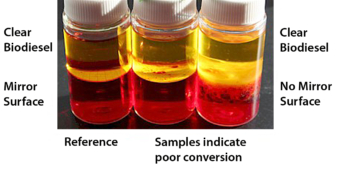
pHLip test results, showing fuel quality problems. Photo: www.biodieselcommunity.org
Several simple fuel quality tests are also described on the Journey to Forever website. These include the “wash test,” “reprocessing test,” “methanol test,” and others. While most of these are mainly of interest to biodiesel fuel makers, some are within the capability of technically minded fuel consumers, too.
Conclusion
Biodiesel users should take some basic precautions to avoid performance problems:
- Perform regular maintenance, check fuel filters frequently, and change them as necessary.
- Understand biodiesel’s cold weather properties and take appropriate precautions.
- Be aware of biodiesel’s incompatibility with certain materials and replace any incompatible parts, especially rubber fuel lines.
- Regularly drain water from the bottom of fuel tanks, to prevent microbial growth.
- Use stored biodiesel within about six months.
- Make sure that fuel meets ASTM D6751.
- Incorporate biodiesel into farming operations gradually. Start slowly and expand your use of the fuel as you gain confidence.
- Make sure your biodiesel comes from a reputable source. Get to know your fuel provider and ask questions about feedstocks and quality testing.
Biodiesel Use, Handling, and Fuel Quality
By Andrew Pressman and Mike Morris, NCAT Agriculture Specialists
Published September 2007
© NCAT
IP315
Slot 314
This publication is produced by the National Center for Appropriate Technology through the ATTRA Sustainable Agriculture program, under a cooperative agreement with USDA Rural Development. This publication was also made possible in part by funding from USDA Risk Management Agency. NCAT.ATTRA.ORG

